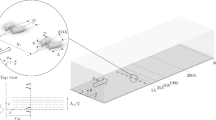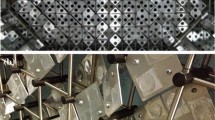Abstract
A high-order direct numerical simulation (DNS) of flow transition over a flat plate at a free stream Mach number 0.5 has been carried out. During the simulation, we cannot find, according to the classical theory of boundary layer transition, the “hairpin vortex breakdown to smaller structures” in the last stage of flow transition on a flat plate. However, we did discover the so-called spikes as a result of a multibridge or multiring formation. This indicated a large and stable vortex structure which can travel for a long distance. We believe that this is a result of ring heads that are located in an inviscid region. These heads of the “turbulence spot” never seem to break down and persist as a stable structure. In addition, we discovered that the U-shaped vortex is a part of an existing coherent structure instead of a newly generated one. The U-shaped vortex also provides an additional channel to transfer vorticity to the ring from the wall. During travel, the leading primary ring in the front of the spot is sloped and skewed, causing disappearance of the second sweep. As a consequence, no energy is brought down to the lower boundary layer near the vortex ring head of the spot. Thus, the small length scale structures become damped and the existing U-shaped vortex structure becomes distinguishable. So, the question is where do the turbulent small length scale vortices come from? We will address this with a new theory which states that all of small length scales (turbulence) are generated by high-shear (HS) layers rather than being produced by “vortex breakdown.” The new DNS shows that the HS layers are produced by strong positive spikes surrounded by low-speed fluids and by the interaction between the secondary and higher-level vortices and the wall surface especially near the ring neck. This multiple ring-like vortex generation also follows the first Helmholtz vortex conservation law. Furthermore, the Λ-shaped vortex is formed and rolling up, and the Λ-vortex is stretched and narrowed, and a new bridge is generated after the neck. The bridge will further become a second ring and so on. Besides the original vortex legs, there are also U-shaped vortex tubes. Finally, the multiple ring vortex structure is formed. From this process, no evidence is found to support that two consequent multiring circles are mixed to generate small vortices. The connection of downdraft/updraft motions is also studied.
Similar content being viewed by others
Abbreviations
- M ∞ :
-
Mach number
- \({\delta _{in}}\) :
-
Inflow displacement thickness
- T ∞ :
-
Free stream temperature
- Lx :
-
Length of computational domain along x direction
- Ly :
-
Length of computational domain along y direction
- x in :
-
Distance between leading edge of flat plate and upstream boundary of computational domain
- A 2d :
-
Amplitude of 2D inlet disturbance
- ω :
-
Frequency of inlet disturbance
- β :
-
Spanwise wave number of inlet disturbance
- γ :
-
Ratio of specific heats
- ω x :
-
Streamwise vorticity
- λ 2 :
-
Const representing vortex tube surface
- Re :
-
Reynolds number
- T w :
-
Wall temperature
- Lz in :
-
Height at inflow boundary
- A 3d :
-
Amplitude of 3D inlet disturbance
- α 2d :
-
Streamwise wave number of inlet disturbance
- R :
-
Ideal gas constant
- μ ∞ :
-
Viscosity
References
Asai M., Nishioka M.: Boundary-layer transition triggered by hairpin eddies at subcritical Reynolds numbers. J. Fluid Mech. 291, 101–122 (1995)
Bake S., Meyer D., Rist U.: Turbulence mechanism in Klebanoff transition:a quantitative comparison of experiment and direct numerial simulation. J. Fluid Mech. 459, 217–243 (2002)
Boroduln V.I., Gaponenko V.R., Kachanov Y.S.: Late-stage transition boundary-Layer structure: direct numerical simulation and exerperiment. Theoret. Comput. Fluid Dyn. 15, 317–337 (2002)
Chen L., Liu X., Oliveira M., Tang D., Liu C.: Vortical structure, sweep and ejection events in transitional boundary layer. Sci. China Ser. G Phys. Mech. Astron. 39(10), 1520–1526 (2009)
Chen, L., Liu, X., Oliveira, M., Liu, C.: DNS for Ring-Like Vortices Formation and Roles in Positive Spikes Formation, AIAA Paper 2010-1471. Orlando (2010)
Chen L., Tang D., Lu P., Liu C.: Evolution of the vortex structures and turbulent spots at the late-stage of transitional boundary layers. Sci. China Phys. Mech. Astron. 53(1), 1–14 (2010)
Chen L., Liu C.: Numerical study on mechanisms of second sweep and positive spikes in transitional flow on a flat plate. J. Comput. Fluids 40, 28–41 (2011)
Dryganets S.V., Kachanov Y.S., Levchenko V.Y., Ramazanov M.P.: Resonant flow randomization in K-regime of boundary layer transition. J. Appl. Mech. Tech. Phys. 31(2), 239–249 (1990)
Duros F., Comte P., Lesieur M.: Large-eddy simulation of transition to turbulence in a boundary layer developing spatially over a flat plate. J. Fluid Mech. 326, 1–36 (1996)
Guo, H., Wang, J.J., Lian, Q.X.: Spatial reconstruction of vortical structures in transitional boundary layer based on synchronous hydrogen-bubble visualization. In: Proceedings of the XII International Conference on Methods of Aerophysical Research, Part I—Novosibirsk: Institute of Theoretical and Applied Mechanics, pp. 118–124. (2004)
Guo, H., Lian, X.Q., Pan, C.: Sweep and ejection events in transitional boundary layer. Synchronous visualization and spatial reconstruction. In: Proceedings of XIII International Conference on Methods of Aerophysical Research, Part V—Novosibirsk: Publ. House Parallel, pp. 192–197. (2007)
Guo H., Borodulin V.I., Kachanov Y.S., Pan C., Wang J.J., Lian X.Q., Wang S.F.: Nature of sweep and ejection events in transitional and turbulent boundary layers. J Turbul. 11(34), 1–51 (2010)
Hama, F.R., Nutant, J.: Detailed flow-field observations in the transition process in a thick boundary layer. In: Proceedings of 1963 Heat Transfer and Fluid Mechanics Institute, pp. 77–93. Stanford University Press, Palo Alto (1963)
Herbert T.: Secondary instability of boundary layer. Annu. Rev. Fluid Mech. 20, 487–526 (1988)
Jeong J., Hussain F.: On the identification of a vortex. J. Fluid Mech. 285, 69–94 (1995)
Kachanov, Y.S.: On a universal mechanism of turbulence production in wall shear flows. In: Notes on Numerical Fluid Mechanics and Multidisciplinary Design, vol. 86. Recent Results in Laminar—Turbulent Transition, pp. 1–12. Springer, Berlin (2003)
Kachnaov Y.S.: Physical mechanisms of laminar-boundary-layer transition. Annu. Rev. Fluid Mech. 26, 411–482 (1994)
Klebanoff P.S., Tidstrom K.D., Sargent L.M.: The three-dimensional nature of boundary-layer instability. J. Fluid Mech. 12, 1–34 (1962)
Kleiser L., Zang T.A.: Numerical simulation of transition in wall-bounded shear flows. Annu. Rev. Fluid Mech. 23, 495–537 (1991)
Lee C.B., Li R.Q.: A dominant structure in turbulent production of boundary layer transition. J. Turbul. 8, 55 (2007)
Lele S.K.: Compact finite difference schemes with spectral-like resolution. J. Comput. Phys. 103, 16 (1992)
Lee C.B., Li R.Q.: Dominant structure for turbulent production in a transitional boundary layer. J. Turbul. 8, 1–34 (2007)
Liu, X., Chen, L., Oliveira, M., Tang, D., Liu, C.: DNS for Late Stage Structure of Flow Transition on a Flat-Plate Boundary Layer, AIAA Paper 2010-1470. Orlando (2010)
Liu, C., Chen, L.: Study of Mechanism of Ring-Like Vortex Formation in Late Flow Transition, AIAA Paper 2010-1456. Orlando (2010)
Liu, X., Chen, Z., Liu, C.: Late-stage vortical structures and eddy motions in transitional boundary layer status. Chin. Phys. Lett. 27(2) (2010)
Liu, C., Chen, L., Lu, P.: New findings by high order DNS for late flow transition in a boundary layer. J. Model. Simul. Eng. Open access journal and copy right is kept by authors (2011, to appear)
Liu C., Chen L.: Parallel DNS for vortex structure of late stages of flow transition. J. Comput. Fluids 45, 129–137 (2011)
Lu, P., Liu, C., Numerical Study of Mechanism of U-Shaped Vortex Formation, AIAA Paper 2011-0286. (2011)
Lu, P., Liu, C., Numerical Study of Mechanism of Small Vortex Generation in Boundary Layer Transition, AIAA Paper, 2011-0287. (2011)
Malik M.R.: Numerical methods for hypersonic boundary layer stability. J. Comput. Phys. 86, 376–413 (1990)
Nishioka M., Asai M., Iida S.: An experimental investigation of the secondary instability. In: Eppler, R., Fasel, H. (eds) Laminar-Turbulent Transition, pp. 37–46. Springer, Berlin (1980)
Rist U. et al.: Turbulence mechanism in Klebanoff transition: a quantitative comparison of experiment and direct numerical simulation. J. Fluid Mech. 459, 217–243 (2002)
Rist, U., Kachanov, Y.S.: Numerical and experimental investigation of the K-regime of boundary-layer transition. In: Kobayashi, R. (ed.) Laminar-Turbulent Transition, pp. 405-412. Springer, Berlin (1995)
Rist U., Fasel H.: Direct numerical simulation of controlled transition in a flat-plate boundary layer. J. Fluid Mech. 298, 211–248 (1995)
Sandham D., Kleiser L.: The late stages of transition in channel flow. J. Fluid Mech. 245, 319–348 (1992)
Schlichting, H., Gersten, K.: Boundary Layer Theory, 8th revised edn. Springer, Berlin (2000)
Shu C.W., Osher S.: Efficient implementation of essentially non-oscillatory shock-capturing scheme. J. Comput. Phys. 77, 439–471 (1988)
Singer B., Joslin R.: Metamorphosis of a hairpin vortex into a young turbulent spot. Phys. Fluids 6(11), 3724–3736 (1994)
Author information
Authors and Affiliations
Corresponding author
Additional information
Communicated by Zang.
Rights and permissions
About this article
Cite this article
Liu, C., Chen, L., Lu, P. et al. Study on multiple ring-like vortex formation and small vortex generation in late flow transition on a flat plate. Theor. Comput. Fluid Dyn. 27, 41–70 (2013). https://doi.org/10.1007/s00162-011-0247-5
Received:
Accepted:
Published:
Issue Date:
DOI: https://doi.org/10.1007/s00162-011-0247-5




